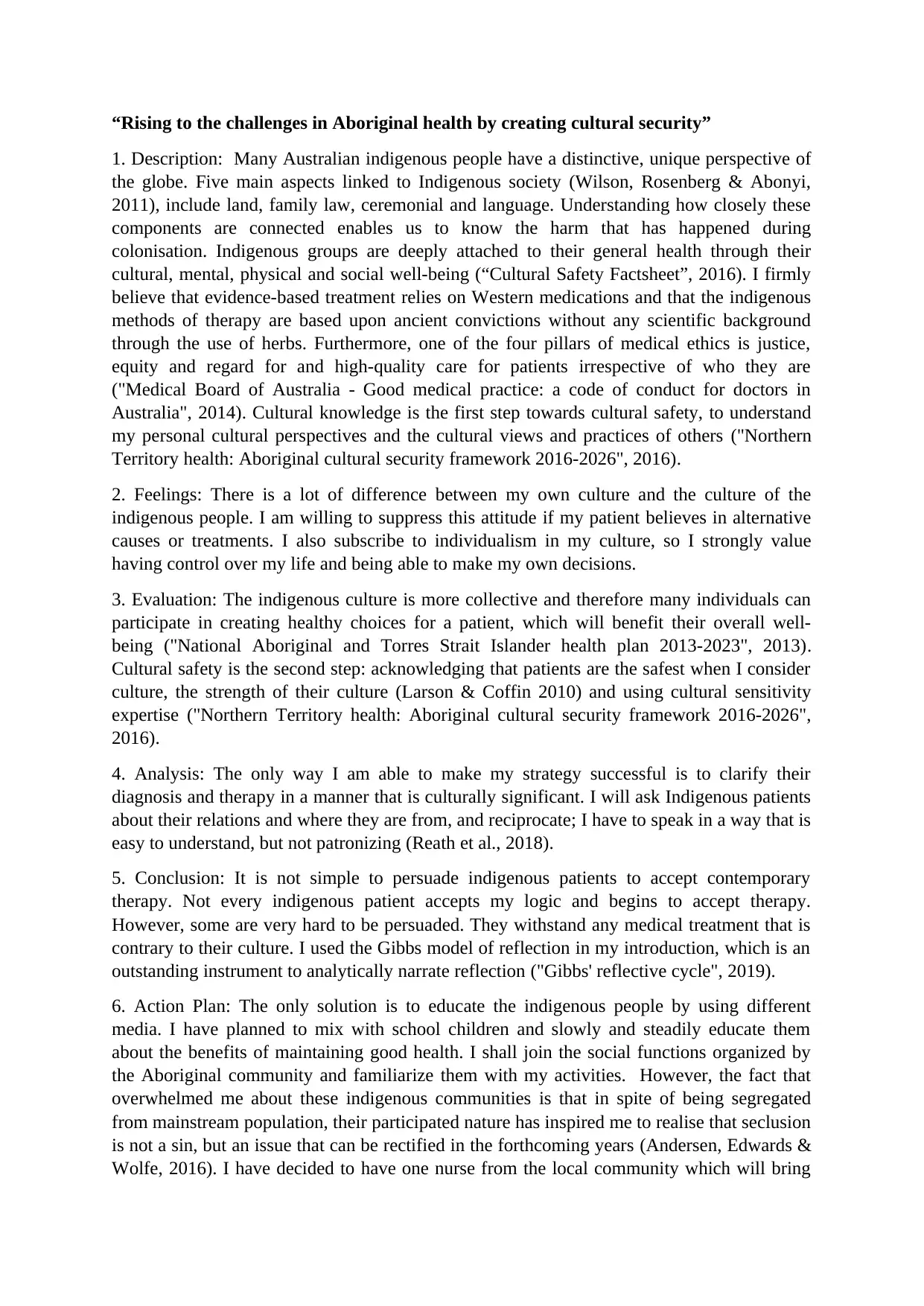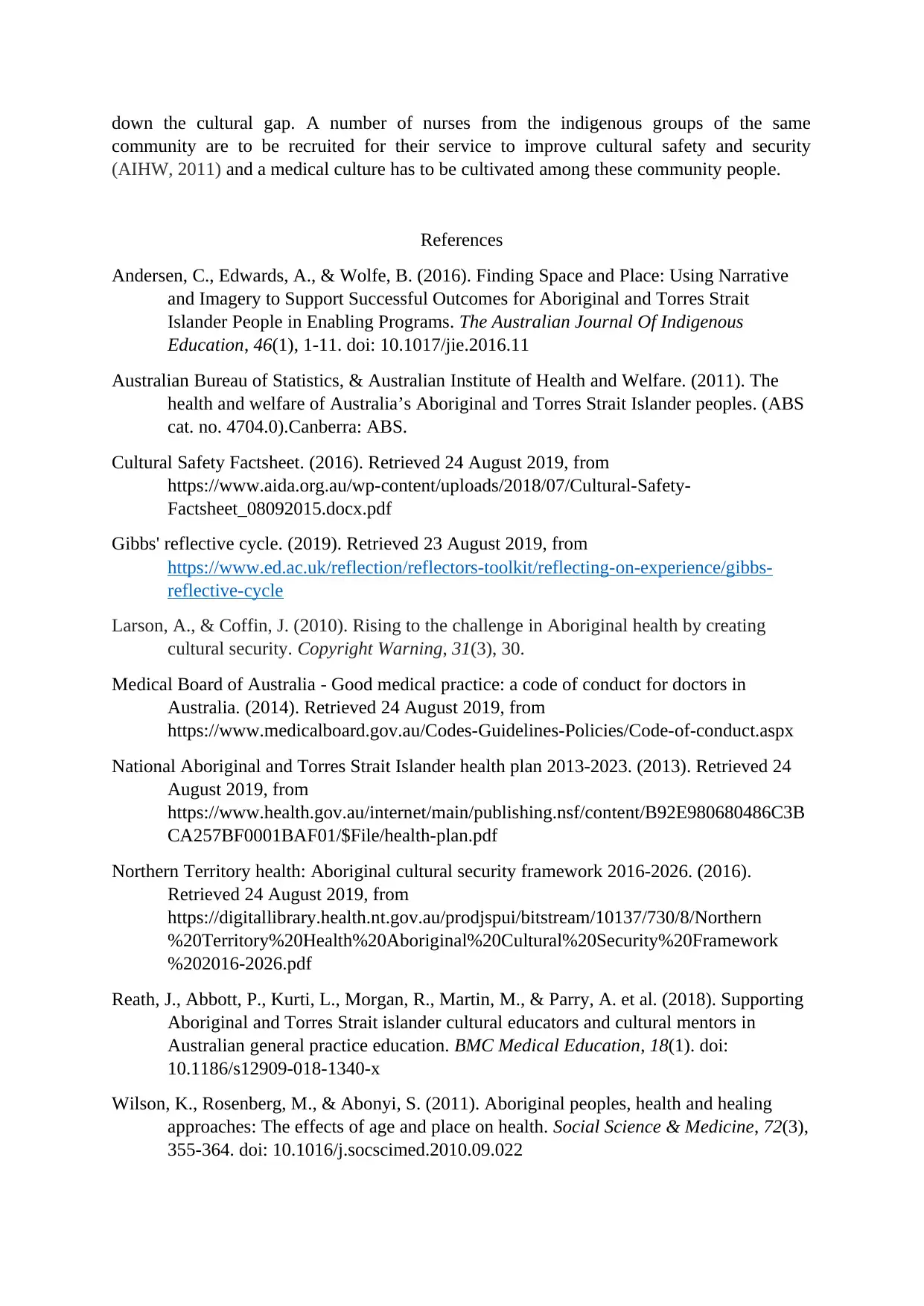INDH1006: Aboriginal Health Reflection and Cultural Security
VerifiedAdded on 2022/09/18
|2
|1096
|26
Report
AI Summary
This report critically reflects on the challenges in Aboriginal health, focusing on the concept of cultural security. The author, using the Gibbs reflective cycle, explores their personal feelings and biases regarding Indigenous culture and healthcare practices. The report emphasizes the importance of cultural awareness, sensitivity, and safety in providing effective healthcare to Aboriginal patients. It acknowledges the differences between Western medicine and traditional Indigenous beliefs, highlighting the need to understand and respect diverse perspectives. The author outlines an action plan that includes educating Indigenous communities about health and recruiting Indigenous healthcare professionals to bridge cultural gaps and improve healthcare outcomes. The report references key literature to support its arguments, underscoring the significance of cultural security in achieving better health outcomes for Aboriginal and Torres Strait Islander peoples.

“Rising to the challenges in Aboriginal health by creating cultural security”
1. Description: Many Australian indigenous people have a distinctive, unique perspective of
the globe. Five main aspects linked to Indigenous society (Wilson, Rosenberg & Abonyi,
2011), include land, family law, ceremonial and language. Understanding how closely these
components are connected enables us to know the harm that has happened during
colonisation. Indigenous groups are deeply attached to their general health through their
cultural, mental, physical and social well-being (“Cultural Safety Factsheet”, 2016). I firmly
believe that evidence-based treatment relies on Western medications and that the indigenous
methods of therapy are based upon ancient convictions without any scientific background
through the use of herbs. Furthermore, one of the four pillars of medical ethics is justice,
equity and regard for and high-quality care for patients irrespective of who they are
("Medical Board of Australia - Good medical practice: a code of conduct for doctors in
Australia", 2014). Cultural knowledge is the first step towards cultural safety, to understand
my personal cultural perspectives and the cultural views and practices of others ("Northern
Territory health: Aboriginal cultural security framework 2016-2026", 2016).
2. Feelings: There is a lot of difference between my own culture and the culture of the
indigenous people. I am willing to suppress this attitude if my patient believes in alternative
causes or treatments. I also subscribe to individualism in my culture, so I strongly value
having control over my life and being able to make my own decisions.
3. Evaluation: The indigenous culture is more collective and therefore many individuals can
participate in creating healthy choices for a patient, which will benefit their overall well-
being ("National Aboriginal and Torres Strait Islander health plan 2013-2023", 2013).
Cultural safety is the second step: acknowledging that patients are the safest when I consider
culture, the strength of their culture (Larson & Coffin 2010) and using cultural sensitivity
expertise ("Northern Territory health: Aboriginal cultural security framework 2016-2026",
2016).
4. Analysis: The only way I am able to make my strategy successful is to clarify their
diagnosis and therapy in a manner that is culturally significant. I will ask Indigenous patients
about their relations and where they are from, and reciprocate; I have to speak in a way that is
easy to understand, but not patronizing (Reath et al., 2018).
5. Conclusion: It is not simple to persuade indigenous patients to accept contemporary
therapy. Not every indigenous patient accepts my logic and begins to accept therapy.
However, some are very hard to be persuaded. They withstand any medical treatment that is
contrary to their culture. I used the Gibbs model of reflection in my introduction, which is an
outstanding instrument to analytically narrate reflection ("Gibbs' reflective cycle", 2019).
6. Action Plan: The only solution is to educate the indigenous people by using different
media. I have planned to mix with school children and slowly and steadily educate them
about the benefits of maintaining good health. I shall join the social functions organized by
the Aboriginal community and familiarize them with my activities. However, the fact that
overwhelmed me about these indigenous communities is that in spite of being segregated
from mainstream population, their participated nature has inspired me to realise that seclusion
is not a sin, but an issue that can be rectified in the forthcoming years (Andersen, Edwards &
Wolfe, 2016). I have decided to have one nurse from the local community which will bring
1. Description: Many Australian indigenous people have a distinctive, unique perspective of
the globe. Five main aspects linked to Indigenous society (Wilson, Rosenberg & Abonyi,
2011), include land, family law, ceremonial and language. Understanding how closely these
components are connected enables us to know the harm that has happened during
colonisation. Indigenous groups are deeply attached to their general health through their
cultural, mental, physical and social well-being (“Cultural Safety Factsheet”, 2016). I firmly
believe that evidence-based treatment relies on Western medications and that the indigenous
methods of therapy are based upon ancient convictions without any scientific background
through the use of herbs. Furthermore, one of the four pillars of medical ethics is justice,
equity and regard for and high-quality care for patients irrespective of who they are
("Medical Board of Australia - Good medical practice: a code of conduct for doctors in
Australia", 2014). Cultural knowledge is the first step towards cultural safety, to understand
my personal cultural perspectives and the cultural views and practices of others ("Northern
Territory health: Aboriginal cultural security framework 2016-2026", 2016).
2. Feelings: There is a lot of difference between my own culture and the culture of the
indigenous people. I am willing to suppress this attitude if my patient believes in alternative
causes or treatments. I also subscribe to individualism in my culture, so I strongly value
having control over my life and being able to make my own decisions.
3. Evaluation: The indigenous culture is more collective and therefore many individuals can
participate in creating healthy choices for a patient, which will benefit their overall well-
being ("National Aboriginal and Torres Strait Islander health plan 2013-2023", 2013).
Cultural safety is the second step: acknowledging that patients are the safest when I consider
culture, the strength of their culture (Larson & Coffin 2010) and using cultural sensitivity
expertise ("Northern Territory health: Aboriginal cultural security framework 2016-2026",
2016).
4. Analysis: The only way I am able to make my strategy successful is to clarify their
diagnosis and therapy in a manner that is culturally significant. I will ask Indigenous patients
about their relations and where they are from, and reciprocate; I have to speak in a way that is
easy to understand, but not patronizing (Reath et al., 2018).
5. Conclusion: It is not simple to persuade indigenous patients to accept contemporary
therapy. Not every indigenous patient accepts my logic and begins to accept therapy.
However, some are very hard to be persuaded. They withstand any medical treatment that is
contrary to their culture. I used the Gibbs model of reflection in my introduction, which is an
outstanding instrument to analytically narrate reflection ("Gibbs' reflective cycle", 2019).
6. Action Plan: The only solution is to educate the indigenous people by using different
media. I have planned to mix with school children and slowly and steadily educate them
about the benefits of maintaining good health. I shall join the social functions organized by
the Aboriginal community and familiarize them with my activities. However, the fact that
overwhelmed me about these indigenous communities is that in spite of being segregated
from mainstream population, their participated nature has inspired me to realise that seclusion
is not a sin, but an issue that can be rectified in the forthcoming years (Andersen, Edwards &
Wolfe, 2016). I have decided to have one nurse from the local community which will bring
Paraphrase This Document
Need a fresh take? Get an instant paraphrase of this document with our AI Paraphraser

down the cultural gap. A number of nurses from the indigenous groups of the same
community are to be recruited for their service to improve cultural safety and security
(AIHW, 2011) and a medical culture has to be cultivated among these community people.
References
Andersen, C., Edwards, A., & Wolfe, B. (2016). Finding Space and Place: Using Narrative
and Imagery to Support Successful Outcomes for Aboriginal and Torres Strait
Islander People in Enabling Programs. The Australian Journal Of Indigenous
Education, 46(1), 1-11. doi: 10.1017/jie.2016.11
Australian Bureau of Statistics, & Australian Institute of Health and Welfare. (2011). The
health and welfare of Australia’s Aboriginal and Torres Strait Islander peoples. (ABS
cat. no. 4704.0).Canberra: ABS.
Cultural Safety Factsheet. (2016). Retrieved 24 August 2019, from
https://www.aida.org.au/wp-content/uploads/2018/07/Cultural-Safety-
Factsheet_08092015.docx.pdf
Gibbs' reflective cycle. (2019). Retrieved 23 August 2019, from
https://www.ed.ac.uk/reflection/reflectors-toolkit/reflecting-on-experience/gibbs-
reflective-cycle
Larson, A., & Coffin, J. (2010). Rising to the challenge in Aboriginal health by creating
cultural security. Copyright Warning, 31(3), 30.
Medical Board of Australia - Good medical practice: a code of conduct for doctors in
Australia. (2014). Retrieved 24 August 2019, from
https://www.medicalboard.gov.au/Codes-Guidelines-Policies/Code-of-conduct.aspx
National Aboriginal and Torres Strait Islander health plan 2013-2023. (2013). Retrieved 24
August 2019, from
https://www.health.gov.au/internet/main/publishing.nsf/content/B92E980680486C3B
CA257BF0001BAF01/$File/health-plan.pdf
Northern Territory health: Aboriginal cultural security framework 2016-2026. (2016).
Retrieved 24 August 2019, from
https://digitallibrary.health.nt.gov.au/prodjspui/bitstream/10137/730/8/Northern
%20Territory%20Health%20Aboriginal%20Cultural%20Security%20Framework
%202016-2026.pdf
Reath, J., Abbott, P., Kurti, L., Morgan, R., Martin, M., & Parry, A. et al. (2018). Supporting
Aboriginal and Torres Strait islander cultural educators and cultural mentors in
Australian general practice education. BMC Medical Education, 18(1). doi:
10.1186/s12909-018-1340-x
Wilson, K., Rosenberg, M., & Abonyi, S. (2011). Aboriginal peoples, health and healing
approaches: The effects of age and place on health. Social Science & Medicine, 72(3),
355-364. doi: 10.1016/j.socscimed.2010.09.022
community are to be recruited for their service to improve cultural safety and security
(AIHW, 2011) and a medical culture has to be cultivated among these community people.
References
Andersen, C., Edwards, A., & Wolfe, B. (2016). Finding Space and Place: Using Narrative
and Imagery to Support Successful Outcomes for Aboriginal and Torres Strait
Islander People in Enabling Programs. The Australian Journal Of Indigenous
Education, 46(1), 1-11. doi: 10.1017/jie.2016.11
Australian Bureau of Statistics, & Australian Institute of Health and Welfare. (2011). The
health and welfare of Australia’s Aboriginal and Torres Strait Islander peoples. (ABS
cat. no. 4704.0).Canberra: ABS.
Cultural Safety Factsheet. (2016). Retrieved 24 August 2019, from
https://www.aida.org.au/wp-content/uploads/2018/07/Cultural-Safety-
Factsheet_08092015.docx.pdf
Gibbs' reflective cycle. (2019). Retrieved 23 August 2019, from
https://www.ed.ac.uk/reflection/reflectors-toolkit/reflecting-on-experience/gibbs-
reflective-cycle
Larson, A., & Coffin, J. (2010). Rising to the challenge in Aboriginal health by creating
cultural security. Copyright Warning, 31(3), 30.
Medical Board of Australia - Good medical practice: a code of conduct for doctors in
Australia. (2014). Retrieved 24 August 2019, from
https://www.medicalboard.gov.au/Codes-Guidelines-Policies/Code-of-conduct.aspx
National Aboriginal and Torres Strait Islander health plan 2013-2023. (2013). Retrieved 24
August 2019, from
https://www.health.gov.au/internet/main/publishing.nsf/content/B92E980680486C3B
CA257BF0001BAF01/$File/health-plan.pdf
Northern Territory health: Aboriginal cultural security framework 2016-2026. (2016).
Retrieved 24 August 2019, from
https://digitallibrary.health.nt.gov.au/prodjspui/bitstream/10137/730/8/Northern
%20Territory%20Health%20Aboriginal%20Cultural%20Security%20Framework
%202016-2026.pdf
Reath, J., Abbott, P., Kurti, L., Morgan, R., Martin, M., & Parry, A. et al. (2018). Supporting
Aboriginal and Torres Strait islander cultural educators and cultural mentors in
Australian general practice education. BMC Medical Education, 18(1). doi:
10.1186/s12909-018-1340-x
Wilson, K., Rosenberg, M., & Abonyi, S. (2011). Aboriginal peoples, health and healing
approaches: The effects of age and place on health. Social Science & Medicine, 72(3),
355-364. doi: 10.1016/j.socscimed.2010.09.022
1 out of 2
Related Documents
Your All-in-One AI-Powered Toolkit for Academic Success.
+13062052269
info@desklib.com
Available 24*7 on WhatsApp / Email
![[object Object]](/_next/static/media/star-bottom.7253800d.svg)
Unlock your academic potential
Copyright © 2020–2025 A2Z Services. All Rights Reserved. Developed and managed by ZUCOL.





